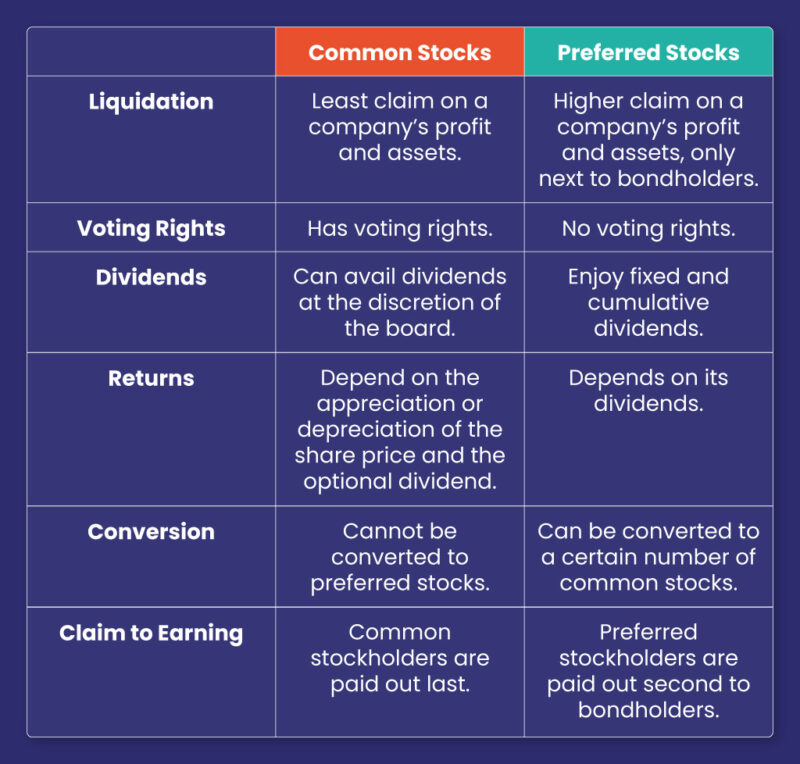
Common Stocks vs Preferred Stocks: What’s the Difference?
Companies raise capital through various means, such as early-stage funding from angel investors and syndicates, lending from financial institutions, reinvesting profits, or issuance of stocks. The issuance of stocks represents the percentage ownership in a company and a form of claim with respect to its assets and revenues. The more stock a shareholder owns, the greater is their ownership stake in that company.
Primarily, there are two kinds of stocks issued by the US companies- common stocks and preferred stocks. In this article, we dive into common stocks vs. preferred stocks based on certain parameters.
What are Common Stocks?
In our earlier blog post, we discussed that the “incorporation and initial generation of funds through equity are parts of the first steps of company formation.” Common stocks are one of the equity classes that represent partial ownership in a company.
They come with voting rights on policy changes and splitting of stocks, and occasionally, a possibility of dividends. With the company’s progress or growth in the value of its assets, the value of the common stocks can appreciate.
Related: The When and How of Issuing Stock Options to Employees
What are Preferred Stocks?
Often termed as hybrid security, preferred stock represents ownership in a company, combining the shareholder benefits of common stocks and consistent income payment of bonds. Alongside ownership, shareholders avail regular income in the form of dividends and certain tax benefits.
There are different types of preferred stocks:
- Cumulative preferred stocks: On the preferred stocks, a fixed dividend rate for each year is payable on the current or future earnings (profit). If the earnings are insufficient to be paid in any year or a series of years, the dividend accumulates and will be drawn from the future earnings.
- Non-cumulative preferred stocks: For these stocks, a fixed rate of dividend is payable only out of the earnings of every year. If the profit for one year is not sufficient to pay the dividend, no dividend arrears will be carried forward to the following year.
- Redeemable preferred stocks: The company can repurchase such stocks at the end of a specified period or by giving prior notice.
- Irredeemable preferred stocks: Such preferred stocks are available or redeemable after the winding up of the company.
- Participating preferred stocks: These stocks give shareholders the right to participate in excess earnings once all other shareholders receive an eligible dividend rate.
Related: How Are Stock Options Taxed in the US?
Common Stocks vs Preferred Stocks: Six Key Differences

1. Liquidation
Stockholders with preferred stocks have a higher claim on a company’s profits and assets than those holding common stocks upon liquidation. The priority of preferred stockholders is also extended to bankruptcy.
If a company goes bankrupt and is liquidated, preferred stockholders are next to bondholders whereas common stockholders come last in the line.
- Voting rights
Even though both common and preferred stockholders represent ownership in a company, the holders of common stocks avail voting rights while preferred stockholders do not. Say, in a major business decision, common stockholders would have a say on the matter while that is not the case for preferred stockholders.
- Dividends
Both preferred and common stockholders can avail dividends. However, the nature of dividends differs in both. Preferred stockholders enjoy fixed and cumulative dividends whereas common stockholders can avail dividends that are paid out at the discretion of the board. Preferred stockholders are also prioritised over holders of common stocks in case of dividend payments.
Often, the company uses the cash on its balance sheet for purposes like completing a share buyback, investing the cash into low-yield investments like marketable securities instead of paying out dividends to common stockholders.
- Returns
The returns on preferred stocks are primarily based on its dividends whereas the return on common stocks depend on the appreciation or depreciation of the share price and the optional dividend. The price of common stocks is reliant on the market perception of the company and the share price.
- Conversion
Preferred stocks can be converted to a certain number of common stocks whereas common stocks cannot be converted to preferred stocks.
- Claim to earnings
When a company reports earnings, bondholders are prioritised first with regards to claiming earnings. Preferred stockholders are paid after the bond stockholders, while common stockholders are paid out last.
trica equity is India’s leading equity and cap table management product for startups and investors. Click here to know more or book a demo.
ESOP & CAP Table
Management simplified
Get started for free





